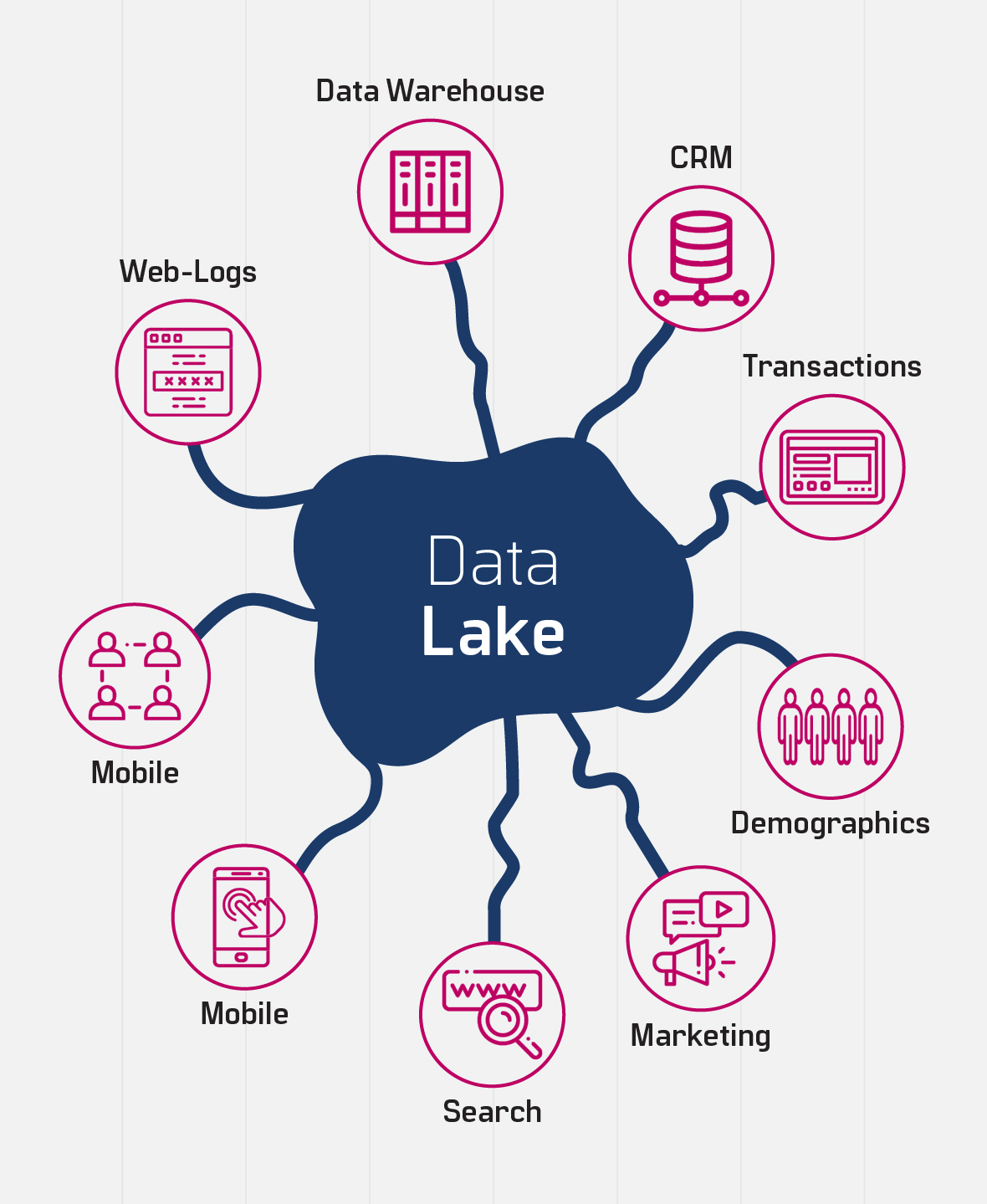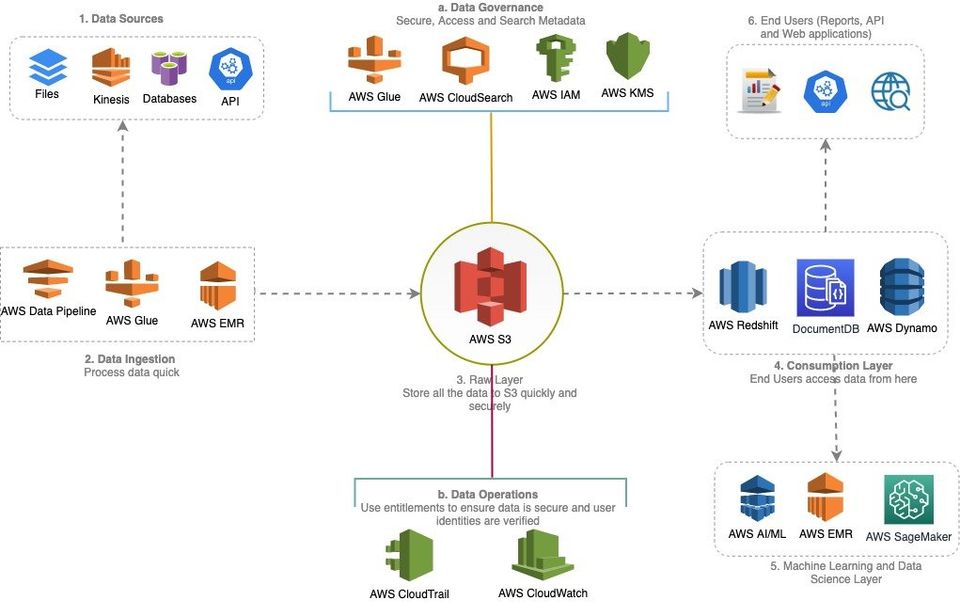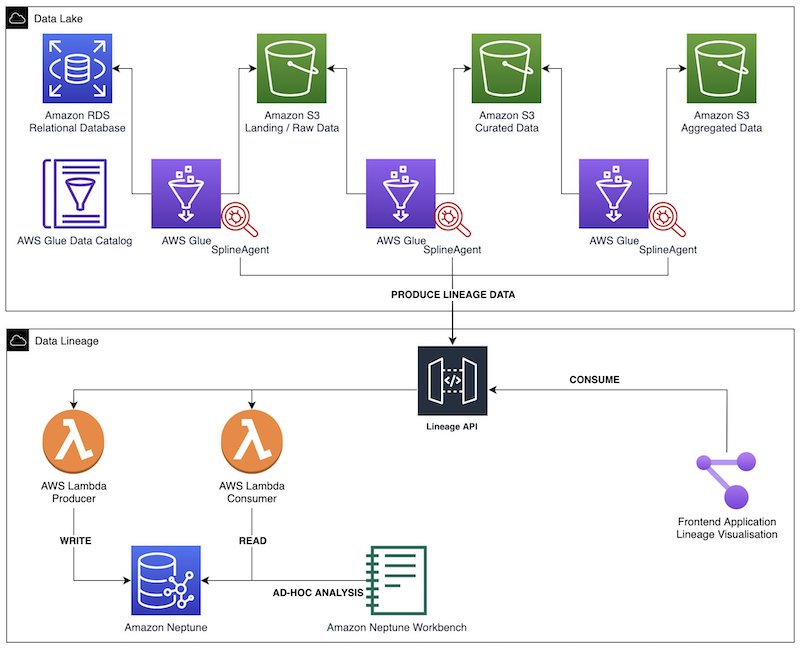Introduction: Understanding Data Lakes and AWS Search Engine
Data lakes have emerged as a powerful tool in modern data management, offering a centralized repository for structured and unstructured data. They enable organizations to store vast amounts of data and apply various analytics techniques to extract valuable insights. However, efficiently searching and retrieving data from data lakes can be challenging due to their sheer size and complexity.
Amazon Web Services (AWS) offers a robust search engine solution for data lakes, addressing the challenge of data retrieval. The amazon web services search engine for data lakes combines several powerful AWS services, such as Amazon Elasticsearch, Amazon Kendra, and AWS Glue, to create a centralized, scalable, and cost-effective search engine for data lakes. This solution allows organizations to harness the full potential of their data lakes by enabling efficient data retrieval and analysis.
Why Choose AWS for Data Lake Search Engine?
Amazon Web Services (AWS) has emerged as a preferred choice for organizations seeking a robust and reliable data lake search engine. Several factors contribute to AWS’s popularity in this domain:
- Scalability: AWS allows you to scale your data lake search engine seamlessly, accommodating the growing needs of your organization. You can easily handle increasing data volumes, user queries, and analytical requirements without worrying about performance or resource constraints.
- Cost-effectiveness: With AWS, you can build and manage a data lake search engine at a lower cost compared to traditional solutions. AWS’s pay-as-you-go pricing model ensures that you only pay for the resources you consume, making it an affordable choice for businesses of all sizes.
- Seamless integration: AWS offers a wide range of services that can be easily integrated to build a comprehensive data lake search engine. This integration enables you to leverage the full potential of AWS’s ecosystem, creating a cohesive and efficient data management and analytics platform.
By choosing AWS as your data lake search engine, you can unlock the true potential of your data, drive informed decision-making, and gain a competitive edge in your industry.
Key AWS Services for Data Lake Search Engine
Amazon Web Services (AWS) offers a variety of services that can be leveraged to build an efficient data lake search engine. Here are some essential AWS services to consider:
Amazon Elasticsearch
Amazon Elasticsearch is a fully managed search and analytics service that makes it easy to search, analyze, and visualize data in real-time. It offers a scalable, cost-effective, and secure solution for building a data lake search engine, enabling you to quickly discover and analyze valuable insights from your data.
Amazon Kendra
Amazon Kendra is an intelligent search service that uses machine learning to provide more accurate and natural-language search capabilities. It enables users to search across multiple data sources and formats, making it an ideal choice for building a comprehensive data lake search engine.
AWS Glue
AWS Glue is a fully managed extract, transform, and load (ETL) service that makes it easy to move data between data stores. It offers a serverless architecture, automatic schema discovery, and flexible data transformation capabilities, enabling you to efficiently prepare and load data into your data lake search engine.
By combining these AWS services, you can create a powerful and customizable data lake search engine tailored to your organization’s unique needs and requirements.
How to Implement an AWS-Powered Data Lake Search Engine: A Step-by-Step Guide
Implementing an AWS-powered data lake search engine involves several steps. Here’s a comprehensive guide to help you get started:
Step 1: Set up your AWS environment
Begin by creating an AWS account and setting up your environment. Ensure that you have the necessary permissions and access to AWS services such as Amazon Elasticsearch, Amazon Kendra, and AWS Glue.
Step 2: Design your data lake architecture
Plan your data lake architecture based on your organization’s unique needs and requirements. Consider factors such as data formats, data sources, and data storage. Ensure that your architecture is scalable, cost-effective, and secure.
Step 3: Ingest data into your data lake
Use AWS Glue to extract, transform, and load (ETL) data from various sources into your data lake. AWS Glue offers automatic schema discovery and flexible data transformation capabilities, making it easy to prepare and load data into your data lake.
Step 4: Index your data
Index your data using Amazon Elasticsearch or Amazon Kendra to enable efficient data retrieval and analysis. Both services offer powerful search and analytics capabilities, enabling you to quickly discover and analyze valuable insights from your data.
Step 5: Query your data
Use Amazon Elasticsearch or Amazon Kendra to query your data and retrieve the information you need. Both services offer flexible querying capabilities, enabling you to search for data using various parameters and filters.
Step 6: Monitor and optimize your data lake search engine
Monitor the performance of your AWS-powered data lake search engine and optimize it for better efficiency. Use AWS tools such as CloudWatch and CloudTrail to monitor your environment, and employ techniques such as query optimization, caching, and load balancing to improve performance.
By following these steps, you can successfully implement an AWS-powered data lake search engine and unlock the true potential of your data.
Real-Life Applications: Success Stories of AWS Data Lake Search Engine
Many businesses have successfully implemented Amazon Web Services (AWS) as their data lake search engine, reaping numerous benefits. Here are some success stories and case studies that highlight the achievements and best practices of these organizations:
Case Study 1: Media and Entertainment Company
A media and entertainment company used AWS to build a data lake search engine, enabling them to efficiently search and analyze large volumes of multimedia content. By leveraging Amazon Elasticsearch and AWS Glue, the company was able to index and query their data in real-time, reducing search times from hours to minutes.
Case Study 2: Retail Giant
A retail giant utilized AWS to create a data lake search engine for their e-commerce platform. By integrating Amazon Kendra and Amazon Elasticsearch, the company was able to provide more accurate and natural-language search capabilities, improving customer experience and driving sales.
Case Study 3: Healthcare Provider
A healthcare provider used AWS to build a data lake search engine for their electronic health records (EHR) system. By leveraging Amazon Elasticsearch and AWS Glue, the company was able to efficiently search and analyze patient data, improving patient care and outcomes.
These success stories demonstrate the power and versatility of AWS as a data lake search engine. By following best practices and leveraging the right AWS services, businesses can unlock the true potential of their data and drive informed decision-making.
Security and Compliance: Ensuring Data Protection in AWS Data Lake Search Engine
Security and compliance are critical considerations when building a data lake search engine. Amazon Web Services (AWS) offers several measures to ensure data protection and regulatory compliance, including:
Encryption
AWS provides encryption capabilities to secure data at rest and in transit. You can use encryption keys managed by AWS Key Management Service (KMS) or bring your own encryption keys. Amazon Elasticsearch and Amazon Kendra support encryption at rest and in transit, ensuring that your data is protected throughout the search engine lifecycle.
Access control
AWS offers fine-grained access control capabilities, enabling you to manage user access and permissions to your data lake search engine. You can use AWS Identity and Access Management (IAM) to create and manage AWS users and groups, and define their access to AWS resources. Additionally, you can use resource-based policies, such as bucket policies in Amazon S3, to control access to specific resources.
Logging and monitoring
AWS provides extensive logging and monitoring capabilities, enabling you to track and audit user activity and system events. You can use AWS CloudTrail to log API calls and user activity, and AWS CloudWatch to monitor system performance and identify issues. These capabilities enable you to detect and respond to security threats and ensure regulatory compliance.
By leveraging these security and compliance measures, you can build a secure and compliant data lake search engine on AWS, ensuring that your data is protected and that you meet regulatory requirements.
Optimizing Performance: Tips and Tricks for Fine-Tuning Your AWS Data Lake Search Engine
Optimizing the performance of your AWS data lake search engine is crucial for ensuring efficient data retrieval and analysis. Here are some practical tips and techniques for fine-tuning your AWS data lake search engine:
Query optimization
Optimizing your search queries can significantly improve the performance of your AWS data lake search engine. Consider using techniques such as query profiling, caching, and indexing to optimize your queries. Additionally, consider using Amazon Elasticsearch’s Query DSL (Domain Specific Language) to construct complex search queries and leverage its powerful search capabilities.
Caching
Caching is a powerful technique for improving the performance of your AWS data lake search engine. Consider using Amazon Elasticsearch’s built-in caching capabilities, such as the query cache and the field data cache, to cache frequently accessed data and reduce query response times. Additionally, consider using external caching solutions, such as Amazon ElastiCache, to cache frequently accessed data and reduce the load on your search engine.
Load balancing
Load balancing is a crucial technique for ensuring the high availability and scalability of your AWS data lake search engine. Consider using Amazon Elasticsearch’s built-in load balancing capabilities, such as the Zen discovery and the Cross-Cluster search, to distribute the load across multiple nodes and ensure high availability. Additionally, consider using external load balancing solutions, such as Amazon ELB (Elastic Load Balancer), to distribute the load across multiple nodes and ensure high availability and scalability.
By employing these techniques, you can fine-tune the performance of your AWS data lake search engine, ensuring efficient data retrieval and analysis and driving informed decision-making.
Future Trends: The Evolution of AWS Data Lake Search Engine
The world of data management is constantly evolving, and Amazon Web Services (AWS) is at the forefront of these developments. Here are some future trends and developments in AWS data lake search engine:
Machine learning integration
Machine learning (ML) is becoming increasingly important in data management, and AWS is no exception. AWS offers several ML services, such as Amazon SageMaker, that can be integrated with your data lake search engine to provide advanced analytics capabilities. By leveraging ML, you can unlock insights from your data and drive informed decision-making.
Natural language processing
Natural language processing (NLP) is a powerful technique for extracting insights from unstructured data, such as text documents and social media posts. AWS offers several NLP services, such as Amazon Comprehend, that can be integrated with your data lake search engine to provide advanced NLP capabilities. By leveraging NLP, you can unlock insights from unstructured data and drive informed decision-making.
Real-time analytics
Real-time analytics is becoming increasingly important in data management, and AWS is no exception. AWS offers several real-time analytics services, such as Amazon Kinesis, that can be integrated with your data lake search engine to provide real-time analytics capabilities. By leveraging real-time analytics, you can unlock insights from your data in real-time and drive informed decision-making.
By staying up-to-date with these future trends and developments, you can ensure that your AWS data lake search engine remains at the forefront of data management and analytics, enabling you to unlock insights from your data and drive informed decision-making.








